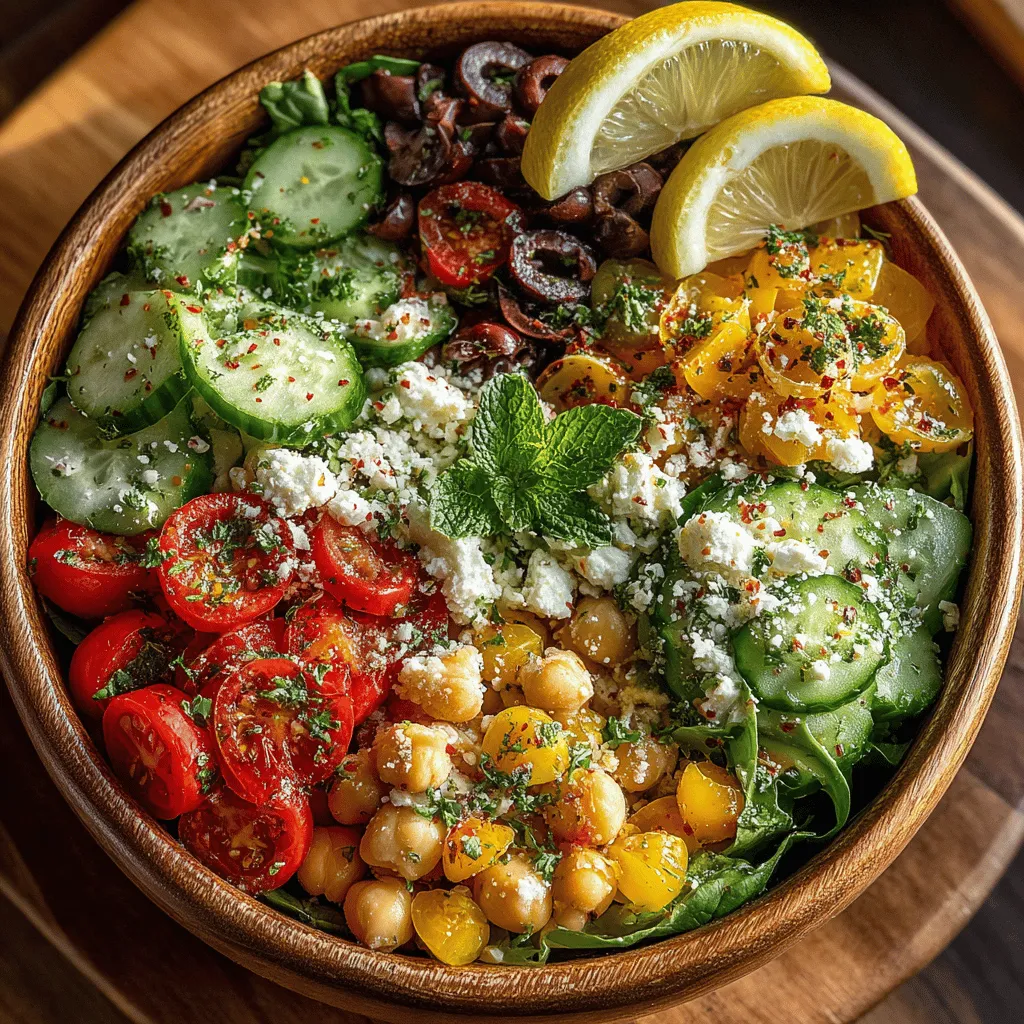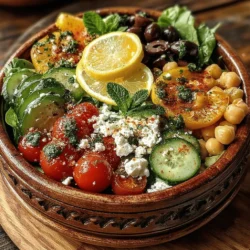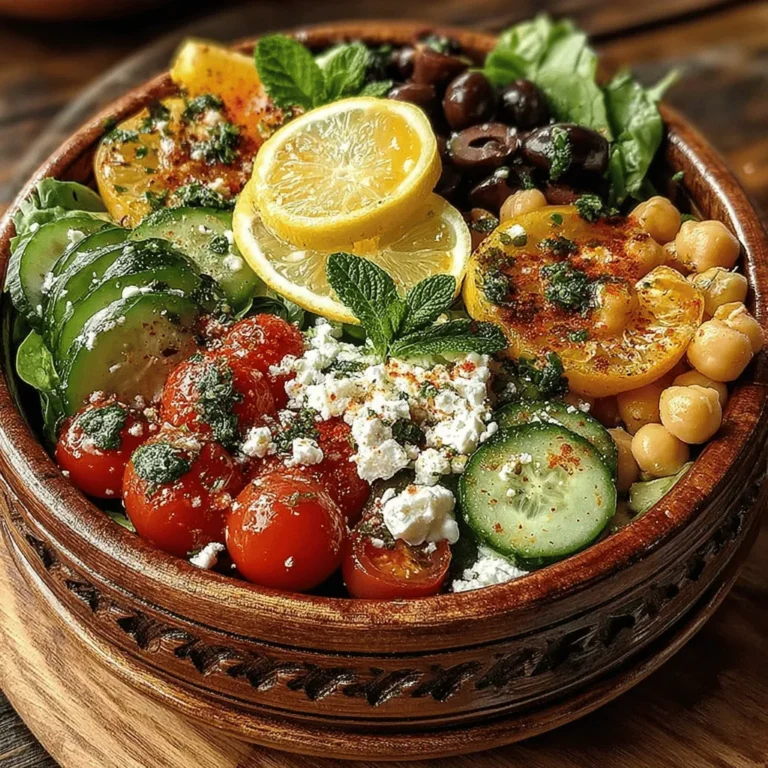Mediterranean Chickpea Salad Bowls: A Fresh and Flavorful Recipe
The Mediterranean diet is renowned for its health benefits, emphasizing the consumption of whole foods, fresh vegetables, lean proteins, and healthy fats. Rooted in the culinary traditions of countries bordering the Mediterranean Sea, this diet has been linked to a myriad of health advantages, including improved heart health, weight management, and reduced risk of chronic diseases. At the heart of this diet lies an abundance of flavorful, nutrient-dense ingredients, and one of the standout components is the chickpea.
Chickpeas, or garbanzo beans, are not only a staple in Mediterranean cuisine but also a powerhouse of nutrition. These legumes are an excellent source of protein, fiber, and essential vitamins and minerals. Their versatility allows them to be used in a multitude of dishes, from hearty stews to vibrant salads. This is where our Mediterranean Chickpea Salad Bowls come into play—a quick, healthy, and satisfying meal option that bursts with flavor and color.
Mediterranean Chickpea Salad Bowls are perfect for anyone seeking a nutritious meal that can be prepared in a matter of minutes. Whether you need a refreshing lunch to take to work or a light dinner after a long day, this salad is a fantastic choice. Packed with a variety of fresh vegetables and aromatic herbs, it’s not only appealing to the eye but also to the palate. The combination of textures and flavors creates a delightful eating experience that is as wholesome as it is delicious.
Understanding the Ingredients
To create the perfect Mediterranean Chickpea Salad Bowl, it’s essential to understand the key ingredients that contribute to its vibrant flavor and nutritional profile. Each component plays a crucial role in delivering a balanced meal that is both satisfying and healthful.
Chickpeas: These protein-packed legumes form the base of our salad. Rich in fiber, chickpeas aid in digestion and help maintain satiety, making them an ideal ingredient for those looking to manage their weight. They are also a good source of folate, iron, and magnesium, supporting various bodily functions and contributing to overall health.
Cherry Tomatoes: These small, juicy fruits are not only sweet and flavorful but are also packed with vitamins C and K, along with antioxidants like lycopene. The bright red hue of cherry tomatoes adds a pop of color to the salad while providing numerous health benefits, including improved skin health and reduced risk of chronic diseases.
Cucumbers: Known for their refreshing crunch, cucumbers are low in calories and high in water content, making them an excellent hydrating ingredient. They are a good source of vitamins K and C, and their crisp texture adds a delightful contrast to the other components of the salad.
Bell Peppers: Available in a variety of colors, bell peppers are rich in vitamins A and C, as well as antioxidants. Their sweet and slightly tangy flavor enhances the overall taste of the salad while providing a colorful visual appeal.
Red Onion: This ingredient serves as a flavor enhancer, adding a mild yet zesty kick to the salad. Red onions are also rich in antioxidants and contain sulfides that may help lower cholesterol levels, making them a healthful addition.
Kalamata Olives: These briny olives are a classic component of Mediterranean cuisine. They provide healthy monounsaturated fats, which are beneficial for heart health, and their unique flavor adds depth to the salad.
Feta Cheese: Crumbled feta cheese brings a creamy texture to the dish, balancing the crunch of the vegetables with its rich and tangy flavor. Feta is lower in fat than many other cheeses and contains beneficial nutrients, such as calcium and protein.
Fresh Herbs (Parsley and Mint): These herbs are essential for elevating the flavors of the salad. Parsley is rich in vitamins A, C, and K, as well as antioxidants, while mint adds a refreshing note that complements the other ingredients beautifully.
Olive Oil and Vinegar: The dressing is a crucial element of any Mediterranean dish. Extra virgin olive oil is a staple of the Mediterranean diet, known for its heart-healthy properties and rich flavor. Combined with vinegar, typically red wine or balsamic, it creates a simple yet delicious dressing that brings all the ingredients together.
Step-by-Step Preparation Guide
Now that we understand the ingredients that make up our Mediterranean Chickpea Salad Bowls, let’s dive into the preparation process. Following these steps will help you create a salad that is not only flavorful but also visually appealing.
1. Preparing the Vegetables: Start by washing all your fresh vegetables thoroughly. For the cherry tomatoes, you can leave them whole or cut them in half if you prefer a smaller bite. Cucumbers should be peeled (if desired) and sliced into half-moons for easy eating. Bell peppers should be deseeded and cut into bite-sized pieces, while red onions can be sliced thinly to deliver just the right amount of bite.
2. Mixing for Freshness: To maintain the freshness of your salad, it’s important to mix the ingredients properly. In a large mixing bowl, combine the chickpeas, cherry tomatoes, cucumbers, bell peppers, and red onion. Gently toss these ingredients together to ensure they are well-distributed without bruising the vegetables.
3. Folding in Greens: If you choose to include fresh greens, such as baby spinach or arugula, fold them in gently at the end. This technique is crucial to preserve the integrity of the greens, preventing them from wilting or becoming overly soggy.
4. Crafting the Dressing: In a separate small bowl, whisk together extra virgin olive oil and your choice of vinegar. Aim for a ratio of about three parts olive oil to one part vinegar for a well-balanced dressing. Season with salt, pepper, and any additional herbs or spices you prefer. Emulsification is key here—whisk vigorously to combine the oil and vinegar into a cohesive dressing.
With these initial steps, you are well on your way to crafting a delicious Mediterranean Chickpea Salad Bowl that showcases the vibrant flavors of the Mediterranean region. This salad is not only quick to prepare but also offers endless possibilities for customization based on your preferences or seasonal ingredients.

Combining Ingredients: Best Practices for a Beautifully Mixed Salad
Creating a visually appealing Mediterranean Chickpea Salad starts with how you combine the ingredients. To achieve a symphony of flavors and colors, begin by placing the chickpeas, diced cucumbers, cherry tomatoes, red onion, and bell peppers in a large mixing bowl. For optimal flavor integration, it’s advisable to mix the chickpeas with the dressing first. This will allow the beans to absorb the flavors before incorporating the fresh vegetables.
Using a gentle folding motion, combine the ingredients rather than stirring vigorously. This technique preserves the integrity of the vegetables, keeping them intact and crunchy while ensuring an even distribution of flavors. If you are using feta cheese, crumble it over the top of the salad just before serving. This allows it to maintain its texture and prevents it from breaking down too much in the mix.
Adding Feta and Herbs: How to Incorporate Without Breaking Them Apart
Feta cheese and fresh herbs are essential components that elevate the Mediterranean Chickpea Salad. After you’ve combined the salad base, sprinkle crumbled feta over the top, ensuring it’s distributed evenly. Use a spoon or spatula to gently fold the feta into the salad without smashing it. The goal is to keep the cheese intact so that it adds delightful bursts of flavor without overwhelming the other ingredients.
For the herbs, such as parsley and mint, chop them finely to release their essential oils and flavors. Sprinkle the chopped herbs over the salad and use the same gentle folding technique to incorporate them. This method helps to maintain the bright freshness of the herbs while distributing their flavor throughout the salad.
Serving Suggestions: Presentation Tips for an Appealing Dish
Presentation plays a crucial role in making your Mediterranean Chickpea Salad Bowls visually enticing. Consider serving the salad in individual bowls or on a large platter. If using a platter, create a colorful arrangement by layering the ingredients instead of mixing them all together. Start with a base of greens, then artfully arrange the chickpeas, vegetables, feta, and herbs in separate sections.
For added flair, garnish with a few whole olives or a sprinkle of paprika on top. Drizzle a little extra olive oil and a squeeze of fresh lemon juice over the top just before serving to enhance the flavors and provide a glossy finish. Pair your salad bowls with lemon wedges on the side for an extra zest when serving.
Nutritional Breakdown
Analysis of the Overall Nutritional Profile of the Mediterranean Chickpea Salad
The Mediterranean Chickpea Salad is not only delicious but also packed with nutritional benefits, making it a fantastic addition to a healthy diet. This salad is rich in plant-based proteins, healthy fats, and various vitamins and minerals. The primary ingredients contribute to a well-rounded nutritional profile.
Caloric Content and Serving Size Information
A typical serving size of Mediterranean Chickpea Salad is approximately one cup. This serving contains about 250-300 calories, depending on the specific quantities of ingredients used. The use of olive oil and feta cheese can increase the caloric content, so it’s essential to measure these components if you are monitoring caloric intake.
Breakdown of Macronutrients (Proteins, Fats, Carbohydrates)
– Proteins: Chickpeas are an excellent source of plant protein, contributing about 15 grams per serving. This helps to keep you feeling full and satisfied.
– Fats: The healthy fats primarily come from olive oil and feta cheese. A serving typically contains around 10-15 grams of fat, predominantly unsaturated fats that are beneficial for heart health.
– Carbohydrates: With about 30 grams of carbohydrates per serving, this salad provides a good source of energy, primarily derived from the chickpeas and vegetables.
Vitamins and Minerals from the Salad Ingredients
The vibrant colors of the salad ingredients indicate a rich array of vitamins and minerals. Here’s a brief overview:
– Vitamin C: Found in bell peppers and tomatoes, which supports the immune system.
– Vitamin A: Present in cucumbers and bell peppers, important for eye health.
– Folate: Chickpeas provide this essential B-vitamin, crucial for cell division and overall health.
– Iron: Chickpeas also contribute to iron intake, which is vital for transporting oxygen in the blood.
Variations and Customizations
Suggestions for Ingredient Swaps to Suit Dietary Preferences
The beauty of the Mediterranean Chickpea Salad lies in its versatility. If you’re looking for vegan options, simply omit the feta cheese or substitute it with a vegan feta alternative. You can also enhance flavor with nutritional yeast, which adds a cheesy taste without dairy.
Ideas for Adding Protein
To make the salad more substantial, consider adding protein sources like grilled chicken, shrimp, or tofu. Grilled chicken breast adds lean protein and pairs exceptionally well with the Mediterranean flavors. If you prefer seafood, shrimp sautéed in garlic and olive oil can elevate the dish further. For a plant-based option, marinated and grilled tofu offers a great texture and absorbs the salad’s flavors beautifully.
Seasonal Variations: Adapting the Salad Based on Available Produce
Take advantage of seasonal produce to keep the salad fresh and exciting. In the summer, consider adding juicy peaches or strawberries for a sweet twist. In the fall, roasted butternut squash can add warmth and depth, while in the winter, feel free to incorporate roasted root vegetables for a heartier meal.
Pairing Suggestions
Ideal Accompaniments for Mediterranean Chickpea Salad Bowls
To round out a meal featuring Mediterranean Chickpea Salad, consider pairing it with warm pita bread or homemade flatbreads. These options provide a delightful contrast in texture and are perfect for scooping up the salad.
Complementary Side Dishes
Serving the salad alongside hummus or tzatziki can enhance the overall Mediterranean experience. These dips are not only delicious but also provide additional flavors that complement the salad’s freshness.
Beverage Pairings
When it comes to beverages, a glass of chilled white wine, such as a Sauvignon Blanc or a light rosé, can be an excellent choice. If you prefer non-alcoholic options, herbal teas such as mint or chamomile offer a refreshing palate cleanser.
Cultural Significance of Mediterranean Cuisine
Brief Exploration of the Mediterranean Region’s Culinary Traditions
Mediterranean cuisine is renowned for its use of fresh, whole ingredients and bold flavors. It’s characterized by an abundance of vegetables, fruits, legumes, whole grains, nuts, and healthy fats, particularly olive oil. The culinary traditions of the Mediterranean region emphasize seasonal and local produce, which is a cornerstone of this cuisine.
How the Mediterranean Diet Promotes Health and Longevity
The Mediterranean diet is often hailed as one of the healthiest dietary patterns worldwide. Numerous studies have shown that this way of eating can reduce the risk of chronic diseases, such as heart disease and diabetes, and promote longevity. The diet’s focus on whole foods and healthy fats, alongside active social dining experiences, contributes to both physical health and emotional well-being.
The Role of Communal Meals and Shared Dishes in Mediterranean Culture
Shared meals are central to Mediterranean culture, promoting community and connection. Eating together allows families and friends to bond over food, fostering relationships and a sense of belonging. The Mediterranean Chickpea Salad, with its colorful presentation and shared nature, epitomizes the joy of communal dining.
Conclusion
Incorporating Mediterranean Chickpea Salad Bowls into your regular meal rotation can offer numerous health benefits while delighting your taste buds. The combination of chickpeas, fresh vegetables, and flavorful herbs creates a nutrient-dense dish that is as versatile as it is delicious.
Exploring the versatility of chickpeas and fresh vegetables not only enhances your culinary repertoire but also encourages a healthier lifestyle. Preparing and sharing this salad with loved ones can transform mealtime into a joyous occasion, celebrating the vibrant flavors and rich traditions of Mediterranean cuisine. So gather your ingredients, enjoy the process, and savor the delightful flavors of this nutritious salad!


